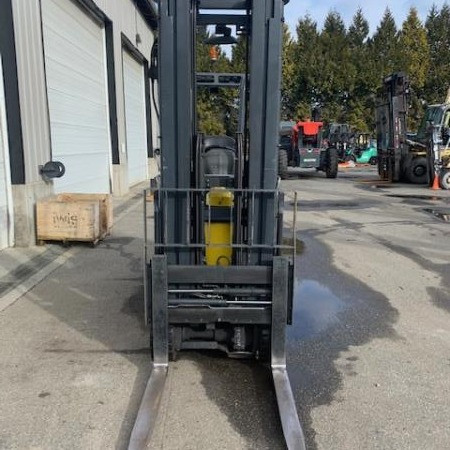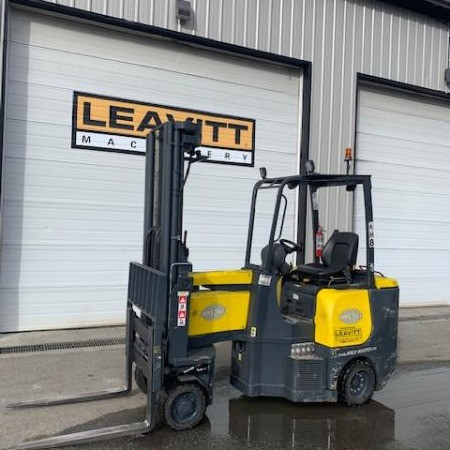Very Narrow Aisle Forklift Corona
Used Very Narrow Aisle Forklift Corona - Getting items from one warehouse location to another and to and from the loading docks is the focus of warehousing. Focus is often on space saving tools and the layout of the building. Narrow aisles need specific solutions to allow goods to be accessed and stored properly. More space can be given to storage as less space is needed for accessing the aisle. Configuring the warehouse is known as warehouse optimization.
Warehouse Optimization
There are several significant benefits of implementing very narrow aisle warehouse optimization.
Since very narrow forklift trucks have been designed to take up significantly less space, warehouse aisle widths can be reduced to half the width needed by traditional forklifts. Numerous narrow aisle forklifts deliver better stacking heights to increase the storage capacity on a square foot basis. This means that costs are decreased because less warehouse space is necessary for the same amount of stock than if a standard aisle configuration were used. In most urban areas where square footage is very costly, this is a huge benefit to warehouse operations. Warehouse storage can be increased up to eighty percent with careful planning when a narrow aisle width configuration is utilized. In addition, a very narrow aisle layout allows for more rack faces as well as better access to products. This usually equates to less travel time gathering and storing product as more product is located within a smaller, more accessible area.
Very narrow aisle layouts and narrow aisle layouts are popular for warehouses. Less than eleven feet of aisle width is needed by narrow aisles. Very narrow aisles usually use an aisle width of approximately 6.5 feet across. Storage options are greatly increased with these aisle width options. However, they also create challenges when turning within the aisles using forklifts for stocking and order picking. A variety of very narrow forklifts have been designed to easily maneuver in narrow aisles.
When selecting a forklift for a job application, it is essential to know the aisle dimensions. Taking note of the proper dimensions will save valuable time and money by avoiding the mistake of acquiring a forklift that will not work in the intended application. Taking note of any utilities, columns or posts is necessary before choosing a particular narrow aisle forklift design to maximize warehouse optimization and safety.
Very Narrow Aisle Forklift Trucks
Rechargeable batteries are typical for powering very narrow aisle forklift trucks and most models are electric. Stand-up riders are a popular design for very narrow aisle forklift trucks. The most commonly used types of very narrow aisle forklift trucks are:
1. Reach trucks
2. Order pickers;
3. End-control riders; and
4. Turret or swing-mast.
Reach Forklift Trucks
The reach trucks were created as a type of rider stacker forklift but can be modified specifically for narrow aisle usage. The reach trucks developed their name from their forward-reaching actions to get a load. The two kinds of reach trucks the moving carriage and the moving mast. The moving carriage works by raising and lowering the carriage and the driver. The moving mast raises and lowers the forks as the operator remains at ground level. The moving mast reach truck is generally considered the safer of the two types of reach trucks. These machines rely on a kind of jointed framework known as a pantograph system that enables the operator to place a load or reach the load without moving the machine.
Order Pickers
Order pickers have been created to pick items from difficult, high racking systems. Order pickers are specific for lighter stock items that can be lifted by hand. They lift the operator up to reach the goods by identifying and choosing certain items to create an order.
End-Control Riders
End-control riders are machines that pick loads up at floor level and move the items horizontally as opposed to lowering or lifting over numerous heights.
Turret or Swing-Mast Forklift
The turret or swing mast very narrow aisle forklifts have a swivel mast that pivots and articulates. The mast swivels allowing pallets to be placed on either the left or right of the forklift.
Guided Very Narrow Aisle Trucks
Rail or wire can guide the very narrow aisle forklift trucks down the aisle securely.
Because the forklift is guided, thereby reducing the possibility of the forklift bumping racks while moving down the aisle, the aisles can be extremely narrow. For rail-guided systems, a series of rails are installed into the floor, on both sides of the aisle, and run along the floor for the length of the aisle, curving around the end of the aisle. Specific wheel guides are on the forklift. These slide into the rails to stop the forklift from moving out of the rail guards.
Wire-guidance forklift systems install wires on the floor instead of rails and the wires run down the middle of the aisle. The wire-guides function similarly to the rail systems except the forklift has a wire-guide system to prevent the machine from traveling where it is not supposed to.
Work Site Considerations
Certain essential considerations need to be dealt with before using a narrow aisle configuration. The narrow aisle units feature tall racking systems. The floor construction and the racks need to be carefully taken into account for everyone’s safety. Four specific areas need to be perfectly prepared before a racking system can be implemented including a level floor, plumb racks, any floor cracks need to be repaired and the floor’s load capacity must be accurate. These locations need to be maintained and monitored continuously.
Level Floor
Because of the height of the racking systems, any slight slope of the floor is likely to negatively affect the plumbness of the racks, especially over time when loads are continuously placed and removed on the racks. Without a level floor foundation, the rack stability could be compromised.
Crack Repair
When there are floor cracks found, they need to be assessed and immediately fixed for safety concerns. Cracks may affect the floor’s level and, when they are approximately 3/8 inches wide, will need to be properly filled with a material at least as hard as the surrounding floor.
Floor Load Capacity
The floor needs to meet specific minimum requirements prior to a narrow aisle configuration. Minimum flooring requirements include concrete measuring three thousand psi and rebar distributed evenly three to four inches below the surface. Depending on the load requirements and configuration, additional reinforcements may be needed.
Plumb Racks
Installing the racks safely and correctly is vital for the entire system. There is a major chance of rack failure if improper installation occurs. All racks need to be plumb and this is one of the most vital aspects of correct installation. Rack shims can help the rack stay plumb to one inch at the height of thirty feet.
Dangerous racking failure can occur if the above steps are not taken. Such failure is likely to result in costly damage to goods, the warehouse facility, forklifts and, worst of all, employees could be significantly injured or even killed. These measurements are vital to the success of installing a safe and productive narrow aisle configuration.
Very Narrow Aisle Forklift PDF
Stock Number: 207213 GL
Make: AISLEMASTER
Model: 44E
Year: 2013
| Stock Number |
207213 GL |
| Make |
AISLEMASTER |
| Model |
44E |
| Year |
2013 |
| Category |
Very Narrow Aisle Forklift |
Stock Number: 208758 GL
Make: AISLEMASTER
Model: 44SE
Year: 2015
| Stock Number |
208758 GL |
| Make |
AISLEMASTER |
| Model |
44SE |
| Year |
2015 |
| Category |
Very Narrow Aisle Forklift |
Stock Number: 209213 GL
Make: AISLEMASTER
Model: 44SE
Year: 2015
| Stock Number |
209213 GL |
| Make |
AISLEMASTER |
| Model |
44SE |
| Year |
2015 |
| Category |
Very Narrow Aisle Forklift |













